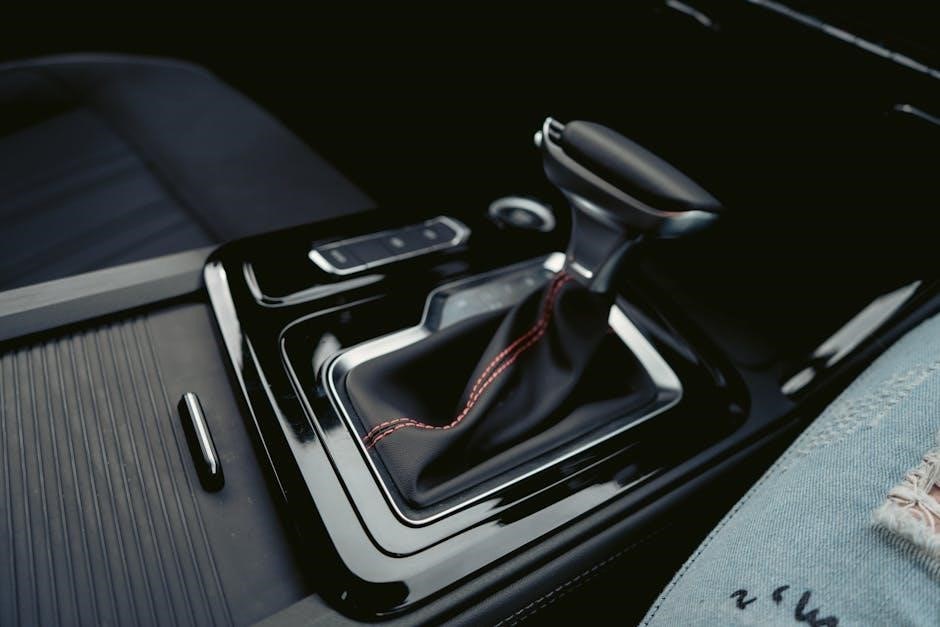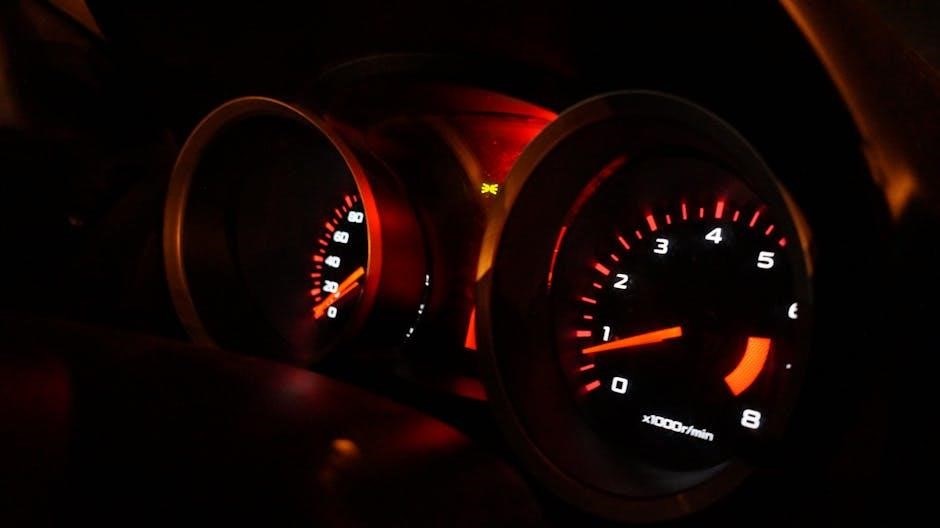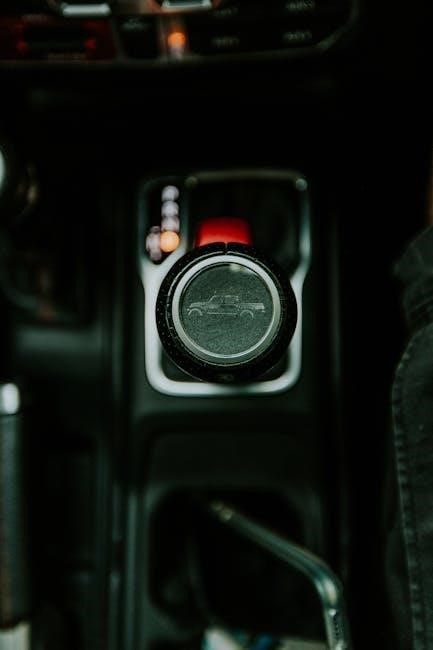Driving a manual car with an automatic licence is illegal and can lead to penalties. An automatic licence restricts you to automatic vehicles, while a manual licence allows both types. Transitioning requires a new test.
What is an Automatic Licence?
An automatic licence is a type of driver’s licence that restricts the holder to operating vehicles with an automatic transmission. It is typically issued to individuals who complete their driving test in an automatic car. This licence does not permit the driver to operate manual transmission vehicles legally. In many countries, driving a manual car with an automatic licence is considered illegal and can result in penalties. The licence is designed for those who prefer the simplicity of automatic vehicles, as they do not require manual gear shifting. However, this limitation means that upgrading to drive manual cars requires additional training and a new driving test. The automatic licence is a common choice for city drivers or those who prioritize convenience over the control offered by manual cars.
What is a Manual Licence?
A manual licence is a driver’s licence that grants the holder the legal authority to operate both manual and automatic transmission vehicles. It is obtained by successfully completing a driving test in a manual car. This licence offers greater flexibility, as it allows drivers to switch between manual and automatic vehicles without restriction. In contrast to an automatic licence, a manual licence demonstrates a higher level of driving skill, as it requires mastery of gear shifting and clutch control. Many countries require drivers to obtain this licence if they wish to drive manual cars legally. Once acquired, it eliminates the need for additional testing to operate automatic vehicles, making it a practical choice for those who desire versatility in their driving capabilities. The manual licence is often preferred by driving enthusiasts who enjoy the engagement and control that manual transmissions provide.

Key Differences Between Manual and Automatic Cars
The primary distinction between manual and automatic cars lies in their transmission systems. Manual cars require drivers to operate a clutch pedal and manually shift gears using a gearstick, offering more control over acceleration and deceleration. Automatic cars, on the other hand, automatically change gears based on speed and throttle input, simplifying the driving process. Manual cars typically have three pedals—clutch, brake, and accelerator—while automatics have only two. Learning to drive a manual car demands more skill and practice, as it involves coordinating clutch and accelerator movements to avoid stalling. Automatics are generally easier to operate, especially in heavy traffic, as they eliminate the need for constant gear shifting. However, manual cars often provide better fuel efficiency and a more engaging driving experience. The choice between the two often depends on personal preference, driving conditions, and the level of control desired.

Legal Implications
Driving a manual car with an automatic licence is illegal and can lead to penalties such as fines or licence suspension. You must obtain a manual licence to legally operate manual vehicles.
Can You Legally Drive a Manual Car with an Automatic Licence?
Legally, driving a manual car with an automatic licence is prohibited in most countries. An automatic licence restricts you to operating vehicles with automatic transmissions only. Driving a manual vehicle without the proper endorsement on your licence is considered illegal and can result in penalties, including fines or licence suspension. In many jurisdictions, such as the UK, Australia, and Canada, a manual licence is required to legally drive both manual and automatic cars, while an automatic licence limits you to automatic vehicles only. In the US, however, there is no distinction between manual and automatic licences, as one licence typically covers both types of transmissions. If you passed your driving test in an automatic car, you are generally not permitted to drive a manual car unless you upgrade your licence. Always check local laws to ensure compliance and avoid legal consequences.
Consequences of Driving a Manual Car with an Automatic Licence
Driving a manual car with an automatic licence carries serious legal consequences. Penalties may include hefty fines, licence suspension, or even prosecution. In many countries, this violation is treated as driving without a valid licence, leading to increased insurance premiums and potential criminal charges. Additionally, if involved in an accident while driving illegally, insurance companies may deny claims, leaving you financially liable. Repeat offences could result in a driving ban. It’s crucial to adhere to licensing laws to avoid these repercussions. Always obtain the correct licence endorsement before operating a manual vehicle to ensure compliance with legal requirements and maintain your driving privileges. Ignoring these regulations can have long-term consequences on your ability to drive legally and safely. Stay informed about local laws to prevent such violations and their associated penalties.
Country-Specific Laws and Regulations
Laws regarding manual and automatic licences vary significantly across countries. In the UK, holding a manual licence allows you to drive both manual and automatic cars, while an automatic licence restricts you to automatic vehicles only. However, in the US, there is no differentiation between manual and automatic licences; a standard driver’s licence permits operation of both types of vehicles. In Australia, if you obtain your licence in an automatic car, you are legally required to pass a manual driving test to upgrade your licence for manual vehicles. Similarly, in Canada, provinces like Ontario issue a G licence for automatic vehicles, requiring a separate G licence with manual transmission endorsement to drive manual cars legally. It’s essential to familiarize yourself with local regulations to avoid legal repercussions. Always verify the specific requirements in your country or region before attempting to drive a manual car with an automatic licence.

Practical Considerations
Upgrading your licence to drive a manual car requires practice and a new driving test. Transitioning from automatic to manual involves mastering clutch control and gear shifting, which can be challenging and time-consuming.
Learning to Drive a Manual Car After Having an Automatic Licence
Transitioning from an automatic to a manual car requires practice and dedication. Start by familiarizing yourself with the clutch and gearshift. Practice in a safe, open area to master coordination between clutch pressing and accelerator use. Builds muscle memory by consistently shifting gears smoothly. Stalling is common initially but improves with time. Consider enlisting a licensed driver or instructor for guidance. Learning proper techniques early prevents bad habits. Understanding when to downshift or upshift is crucial for control and efficiency. Patience is key, as mastering a manual transmission takes time. Once comfortable, gradually transition to real-world driving scenarios. This skill enhances control and engagement while driving, making it worthwhile to learn. Many find the experience rewarding, even if challenging at first.
Challenges of Transitioning from Automatic to Manual
Transitioning from an automatic to a manual car presents several challenges. Coordinating the clutch and accelerator pedals requires practice, and stalling the car is common initially. Building muscle memory for smooth gear shifts takes time. Mastering downshifting and upshifting in various driving situations, such as hills or traffic, can be difficult. Many learners struggle with the physical demands of constant gear changes, especially in heavy traffic. Additionally, the mental effort to stay focused on gear selection while navigating roads can be overwhelming. Learning proper techniques, such as feathering the clutch, is crucial to avoid wear on the transmission. Instructors often recommend starting in a flat, open area to reduce stress. Patience is essential, as progress may be slow. Despite the hurdles, overcoming these challenges can lead to greater control and enjoyment of driving. Persistence and consistent practice are key to becoming proficient in manual driving.
Is It Worth Learning to Drive a Manual Car?
Learning to drive a manual car can be highly rewarding despite the initial challenges. Manual cars generally offer better fuel efficiency and lower maintenance costs compared to automatics. They provide greater control over the vehicle, especially in situations requiring precise speed adjustments, such as driving on steep hills or towing. Additionally, knowing how to drive a manual car broadens your options when renting or purchasing vehicles, as many cars worldwide are manual. It also enhances your driving skills and engagement behind the wheel. While the process of learning may seem daunting, the long-term benefits often outweigh the effort. Many drivers find the experience more enjoyable and empowering. Therefore, investing time to master a manual transmission can be a valuable skill for any driver.

Upgrading Your Licence
Upgrading your licence to include manual transmission requires passing a practical driving test in a manual car. This ensures you meet the necessary standards for operating both types of vehicles legally.
Do You Need to Take a New Driving Test to Drive a Manual Car?
If you hold an automatic licence, driving a manual car typically requires passing an additional practical driving test. This test assesses your ability to safely operate a manual transmission vehicle. The test focuses on skills such as clutch control, shifting gears smoothly, and maintaining vehicle control during various driving scenarios. In many countries, including the UK and Australia, this is a legal requirement to ensure you can handle a manual car competently. Without passing this test, you risk being in violation of driving laws, which can result in penalties or fines. While the process may seem daunting, it provides an opportunity to gain a new skill and expand your driving capabilities. Ultimately, upgrading your licence through this test is essential for legally and confidently driving a manual car.
How to Find a Driving Test in a Manual Car
To find a driving test in a manual car, start by contacting your local driving test center or licensing authority. Many countries allow you to book a manual transmission test online through their official government websites. Additionally, driving schools often provide access to manual vehicles and can assist in scheduling the test. Ensure you practice extensively with a manual car beforehand, as the test will evaluate your ability to handle clutch control, gear shifting, and overall vehicle management. Check availability and requirements in advance, as some regions may have specific procedures or waiting periods. Proper preparation and familiarity with the test format will increase your chances of success. Utilize online resources or instructors to refine your skills before booking the test.
Costs and Time Involved in Upgrading Your Licence
Upgrading your licence to drive a manual car involves specific costs and time commitments. The driving test fee varies by country, with typical ranges between $50 to $200. Additional expenses include lessons from a certified instructor, which can cost $40 to $70 per hour, depending on location and instructor experience. Most learners require 5 to 10 hours of manual transmission practice before feeling ready for the test. Scheduling a test may take 1 to 4 weeks, depending on availability. If you fail the test, you may need to wait a short period before retrying, incurring additional fees. Overall, the process can take 1 to 3 months, including practice and test preparation. Ensure you budget for both the test fee and potential lessons to smoothly transition to a manual licence.

Differences in Driving Experience
Manual cars offer more control and engagement, requiring clutch and gear shifts, while automatics simplify driving with minimal input, reducing stress in heavy traffic conditions, though sacrificing some driver involvement.
Driving a Manual Car vs. an Automatic Car
Driving a manual car requires manual gear shifting and clutch operation, offering greater control and engagement. Automatic cars shift gears automatically, simplifying the process and reducing driver effort, especially in heavy traffic. Manual cars provide a more immersive driving experience, allowing drivers to connect more deeply with the vehicle, while automatics prioritize convenience and ease of use. For inexperienced drivers, automatics are generally easier to master, as they eliminate the need to coordinate clutch and accelerator pedals. However, manual cars often deliver better fuel efficiency and performance in specific driving conditions; The choice between the two ultimately depends on personal preference, driving habits, and the terrain or environment in which the vehicle is primarily used. Both types have unique advantages, catering to different lifestyles and skill levels.
Control and Engagement in Manual Cars
Manual cars provide drivers with enhanced control and a more engaging driving experience. The necessity to operate the clutch and gearshift requires active participation, allowing drivers to feel more connected to the vehicle. This hands-on approach enables precise control over acceleration and deceleration, making it particularly advantageous in situations requiring quick adjustments, such as navigating steep hills or merging onto highways. The direct interaction with the car’s mechanics fosters a sense of mastery and connection, which many drivers find rewarding. Additionally, manual cars often offer better fuel efficiency and performance, as drivers can optimize gear usage according to driving conditions. For those who value driving dynamics and enjoy the tactile experience of shifting gears, manual cars represent a more immersive and satisfying way to drive, even though they may require more skill and attention compared to automatic vehicles.
Safety Considerations for Manual Cars
Manual cars present unique safety considerations, particularly for drivers transitioning from automatic vehicles. The clutch and gearshift require precise coordination, and improper use can lead to loss of control or stalling, increasing accident risks. Stalling in heavy traffic or uphill situations can pose hazards, emphasizing the need for practice. However, manual cars often demand greater driver engagement, reducing distractions like phone use. Additionally, manual transmissions allow drivers to use the clutch for better control in emergencies, such as sudden stops or skidding, provided they are skilled. For inexperienced drivers, mastering these techniques is crucial to ensure safety on the road.

Maintenance and Mechanical Differences
Manual cars have a clutch pedal and manual gearshift, unlike automatics. Maintenance costs for manuals are often lower, but issues like clutch wear require attention. Automatics may have higher repair costs over time.
Maintenance Costs of Manual vs. Automatic Cars
Manual cars generally have lower maintenance costs compared to automatics. The clutch in a manual car can wear out over time and may need replacement, which can be expensive, but such issues are less frequent. Automatic cars, on the other hand, have more complex systems, including torque converters and hydraulic controls, which can lead to higher repair costs when problems arise. Additionally, automatic transmissions often require specialized fluids and filters, which can add to maintenance expenses. However, modern automatics are becoming more efficient and reliable, reducing some of these costs. Overall, while manual cars may require occasional clutch replacements, their simpler design tends to make them more cost-effective in the long run. Automatics, while convenient, may incur higher maintenance costs due to their intricate mechanical components.
Common Issues with Manual Transmissions
Manual transmissions can encounter specific issues that affect performance and longevity. One of the most common problems is clutch wear, which occurs when the clutch plate becomes worn out due to excessive use or improper driving techniques. This can lead to slipping or failure to engage gears properly. Another issue is synchromesh wear, where the synchronizers in the gearbox wear out, causing difficulty in shifting gears smoothly. Additionally, manual transmissions can suffer from gear grinding, often due to driver error or lack of coordination between the clutch and accelerator pedals. Leaks in the transmission system, such as those from the input or output shaft seals, can also lead to fluid loss and eventual system failure. Regular maintenance, such as replacing the clutch and gearbox oil, can help mitigate these issues and ensure smoother operation. Addressing these problems promptly is crucial to avoid more severe damage and costly repairs.
Longevity of Manual vs. Automatic Cars
Manual transmissions are generally considered more durable and longer-lasting than automatics due to their simpler mechanical design. With proper maintenance, a manual gearbox can endure for well over 200,000 miles without major repairs. Automatic transmissions, while improving in reliability, tend to have a shorter lifespan due to their complexity. Components like torque converters and sensors can fail over time, leading to costly repairs. Manual cars often require less expensive repairs when issues arise, as their parts are more accessible and straightforward to replace; However, modern automatics have made significant strides in longevity, especially with advancements in continuously variable transmissions (CVTs) and dual-clutch systems. Despite this, manual transmissions remain the preferred choice for drivers seeking a more robust and cost-effective option in the long term. Ultimately, the choice between manual and automatic depends on personal preference, driving habits, and maintenance practices.
Should You Consider Upgrading Your Licence?
Upgrading your licence to include manual transmission can be beneficial for several reasons. Firstly, it offers greater flexibility, allowing you to drive both manual and automatic vehicles. This can be particularly useful when renting cars abroad or borrowing vehicles from friends, where manual cars are more common. Additionally, driving a manual car provides better control and engagement, which some find more enjoyable. However, upgrading requires passing a manual driving test, which involves learning to use the clutch and gearshift effectively. The process can be challenging, especially for those accustomed to automatics, but it enhances driving skills and opens up more opportunities. If you frequently encounter situations where manual cars are necessary or prefer the driving experience they offer, upgrading your licence is worth considering.
Final Thoughts on Driving a Manual Car with an Automatic Licence
Resources for Further Learning
If you wish to explore more about driving manual cars with an automatic licence, several resources are available to guide you. Official government transportation websites provide detailed information on licence categories and restrictions. Driving schools often offer courses tailored for transitioning from automatic to manual vehicles. Online tutorials and YouTube channels demonstrate practical techniques for mastering manual transmissions. Forums like Reddit or specialized automotive communities share personal experiences and tips. Additionally, books on driving techniques, such as “Driving Manual Cars: A Step-by-Step Guide”, offer in-depth instructions. These resources can help you understand the process and requirements for upgrading your licence or improving your driving skills. Utilizing these tools ensures you make informed decisions and stay compliant with legal standards.